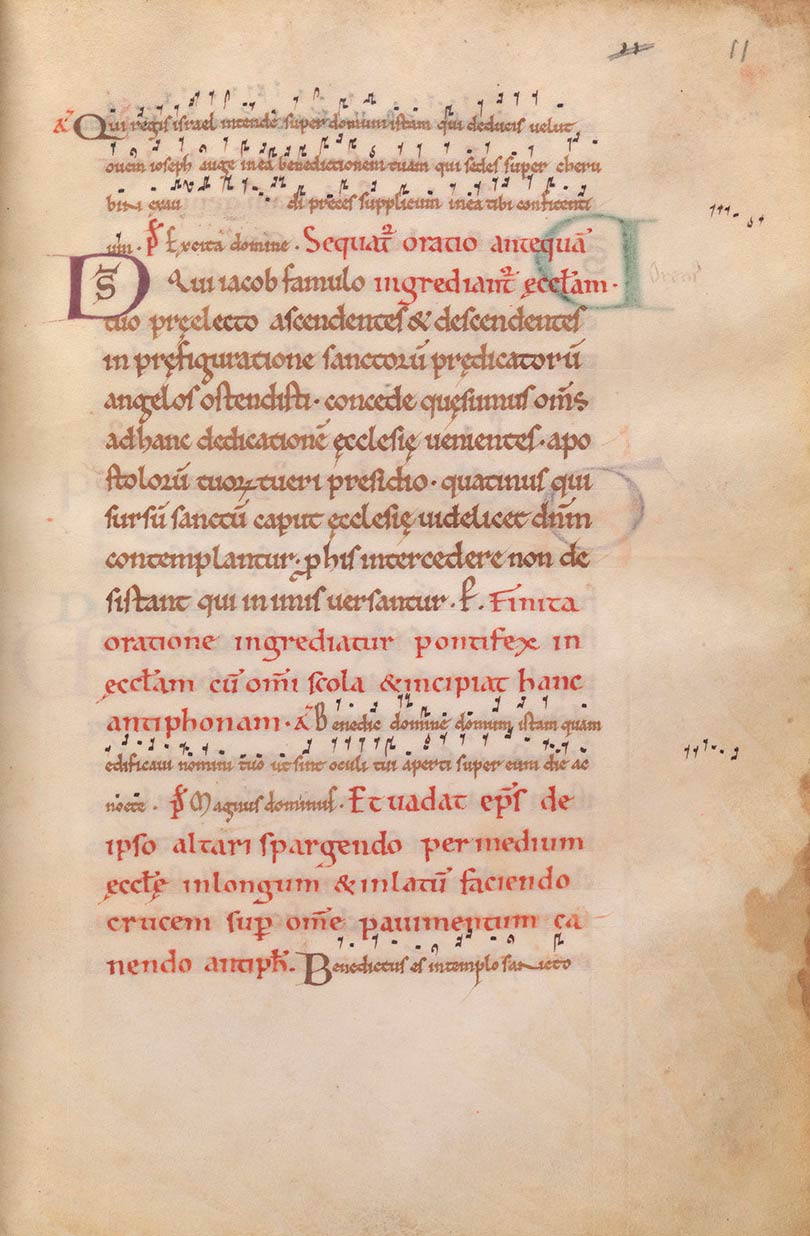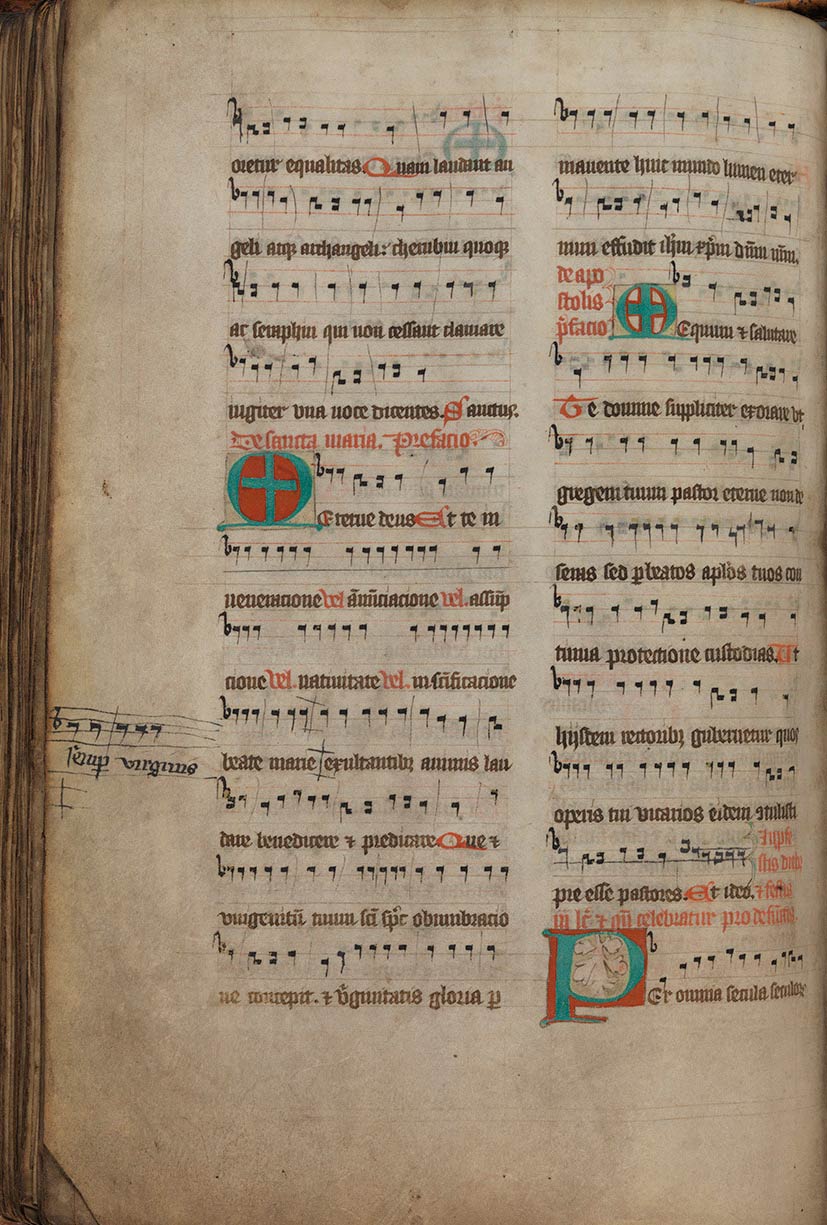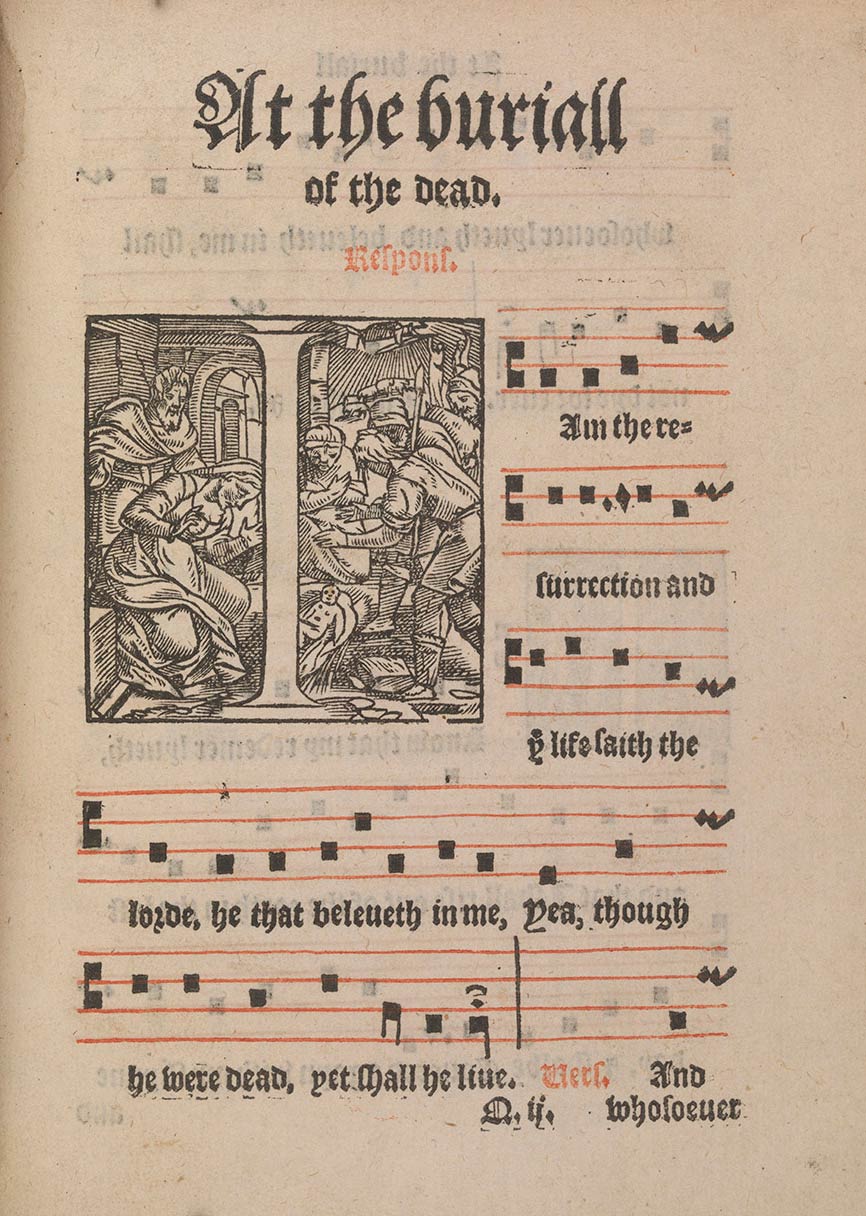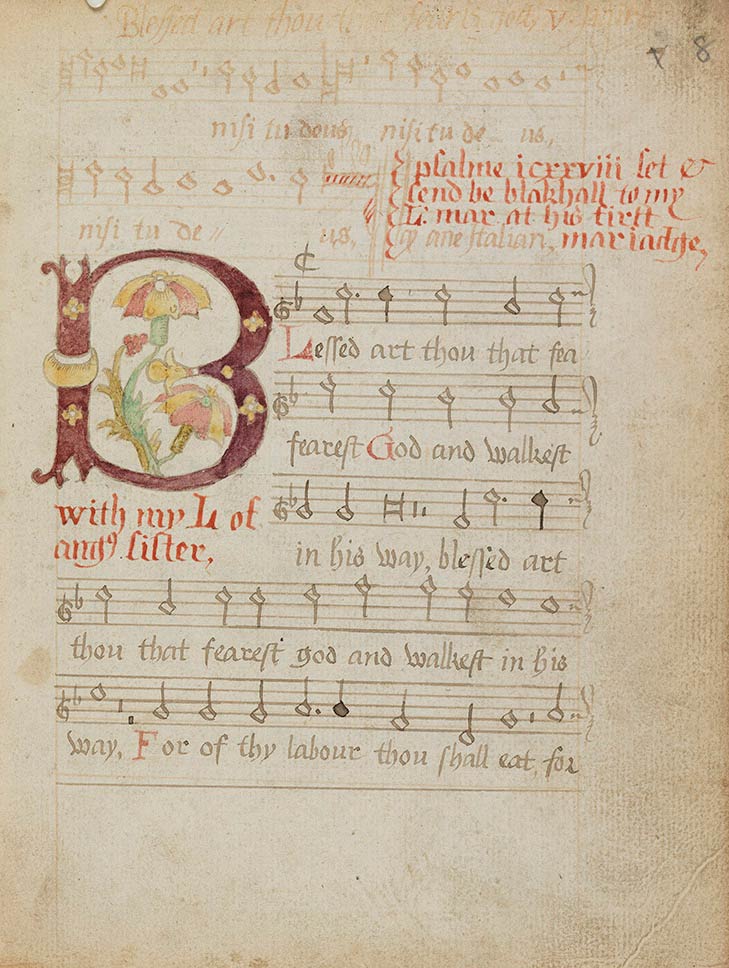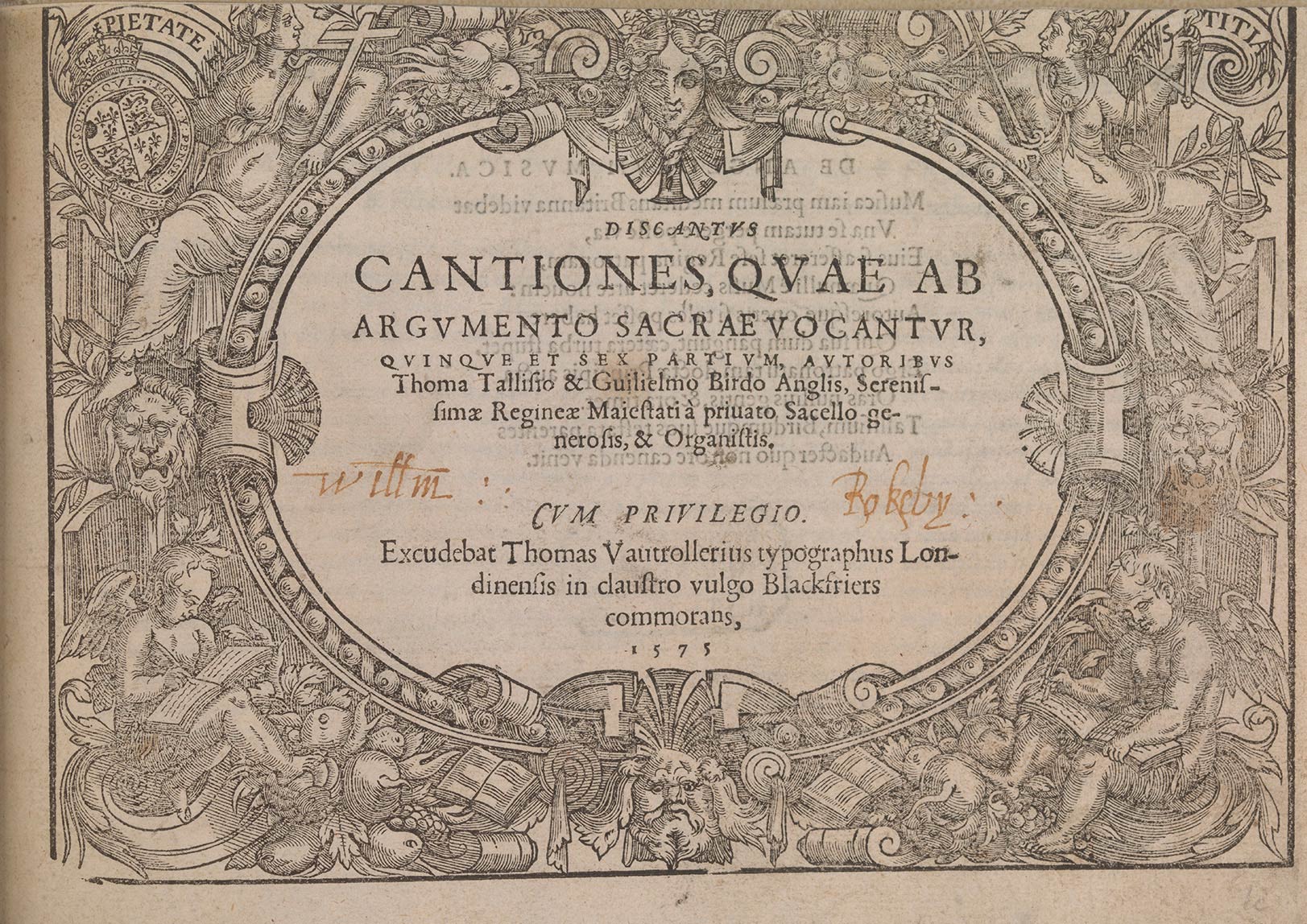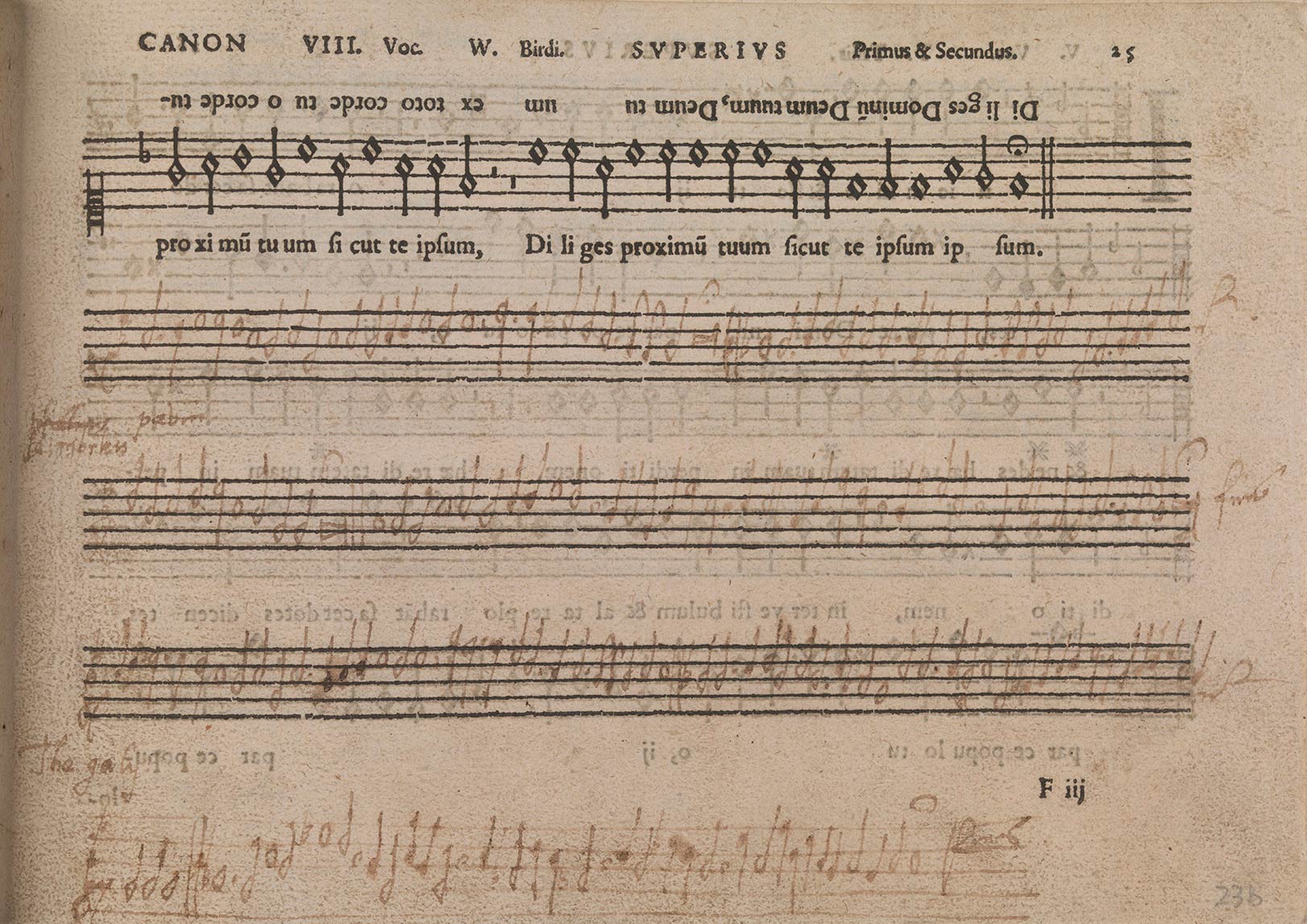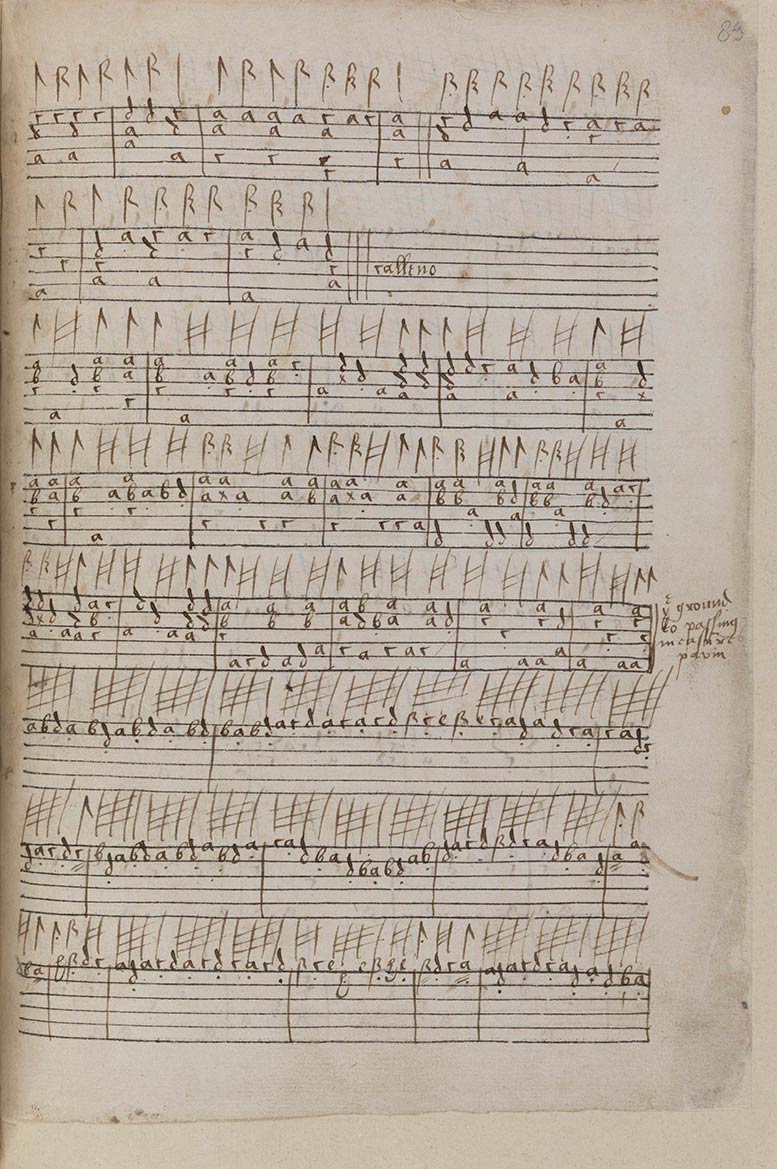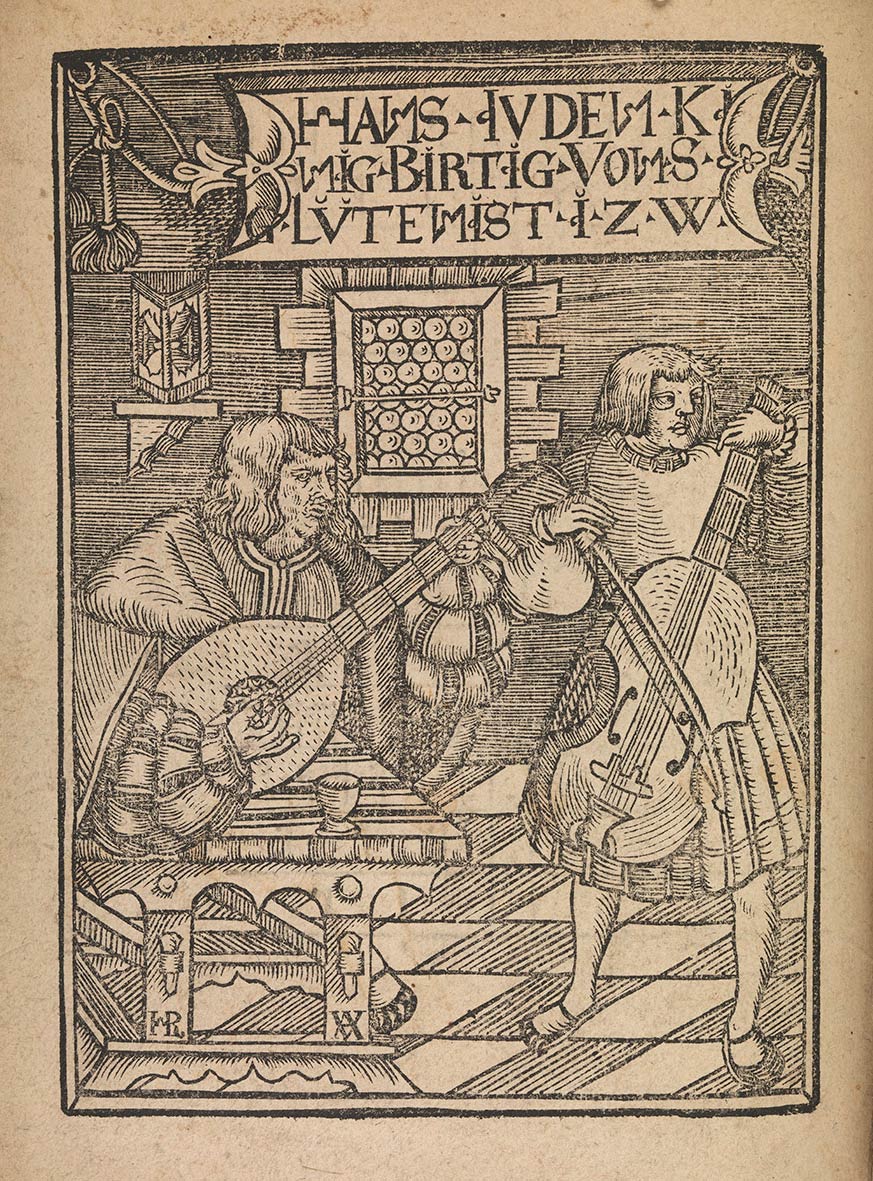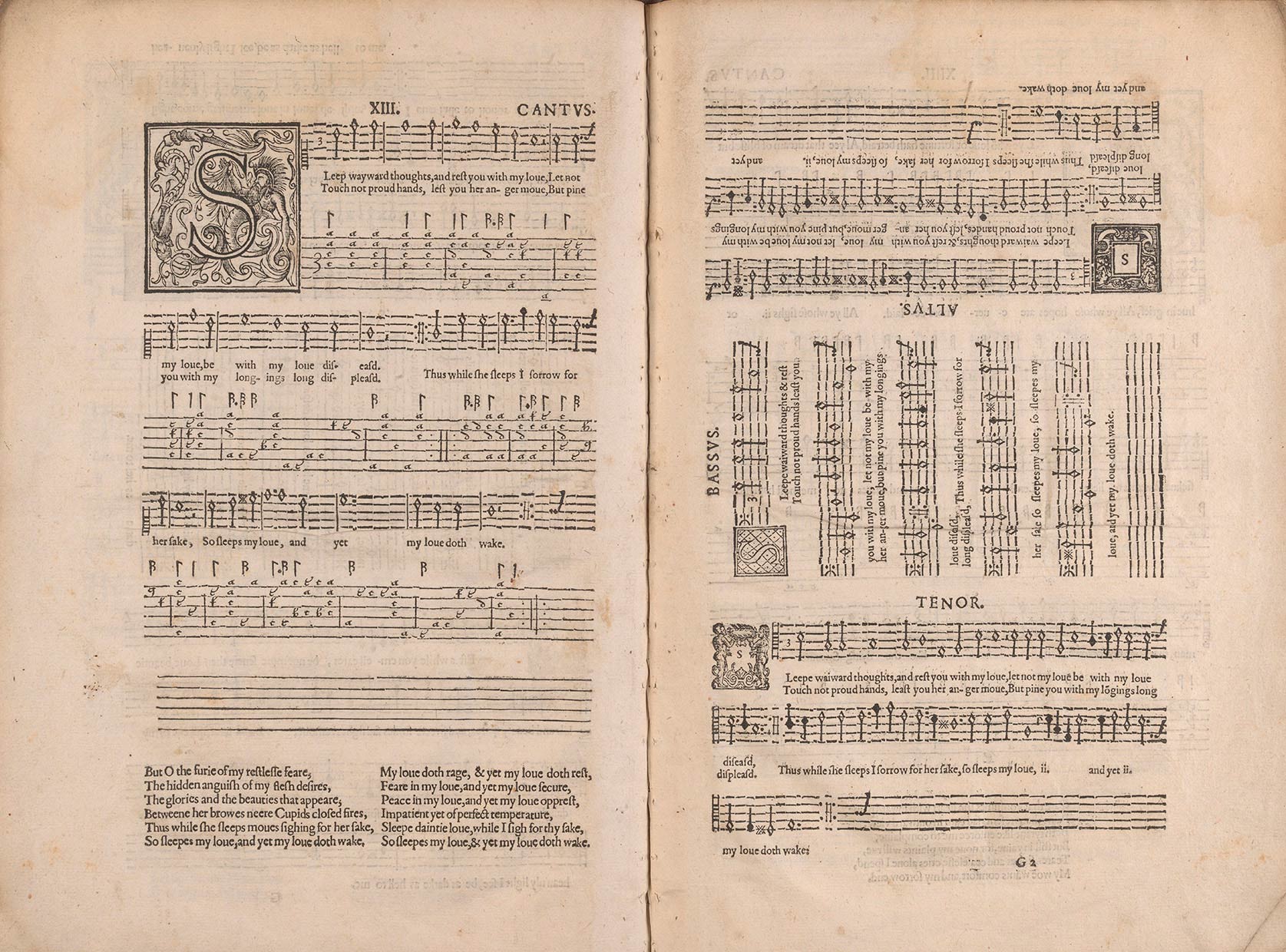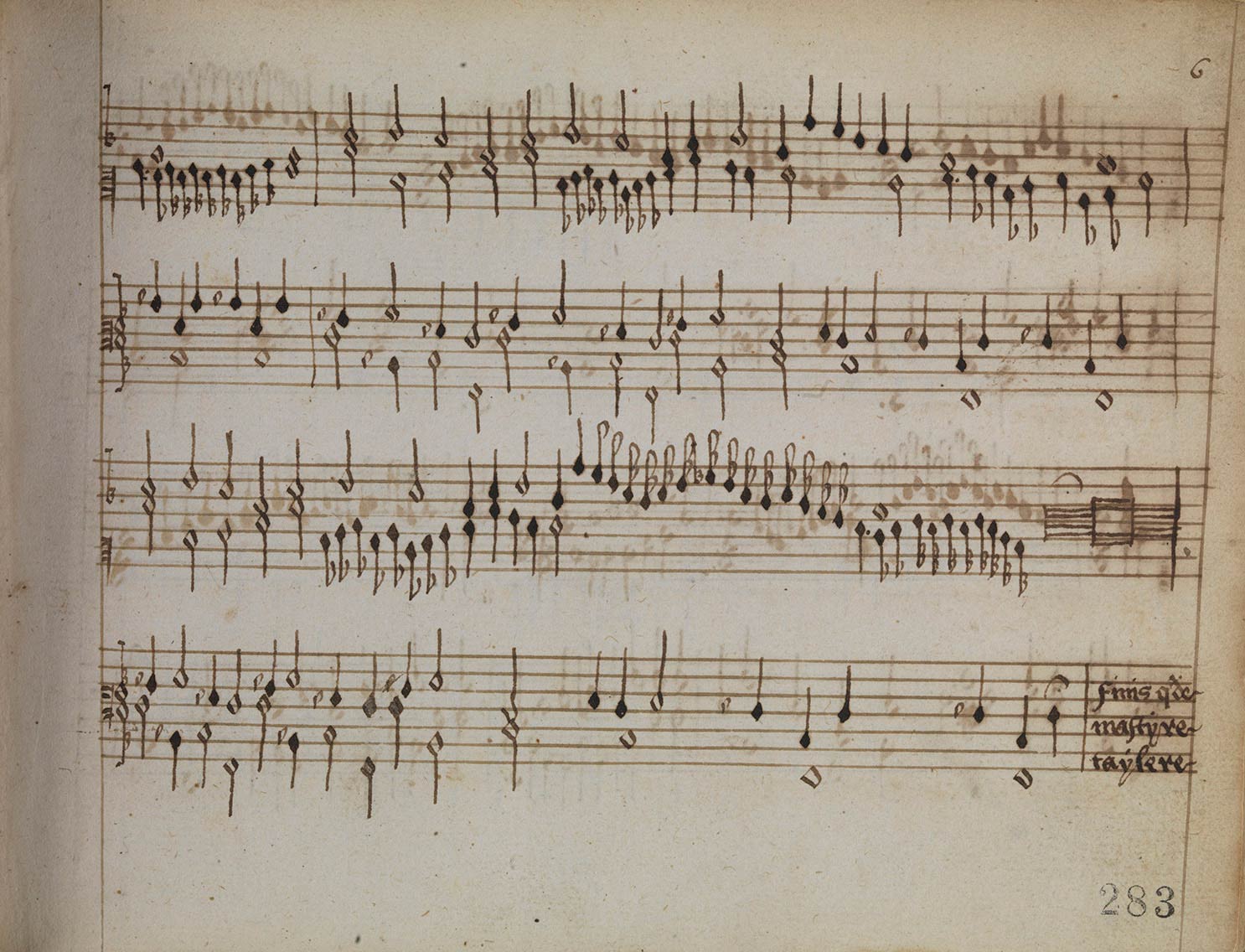Early Music Treasures
Trinity College Library's earliest collections contain significant musical items. These include medieval liturgical manuscripts such as the Canterbury Pontifical and the Kilcormac Missal; music of the Reformation such as Luther's Enchiridion, Merbecke's Book of Common Praier Noted, and the St Andrews Psalter; and domestic music from the Elizabethan era including William Ballet's lute-book, the Dublin Virginal Manuscript, the 1575 Cantiones of Byrd and Tallis, and Dowland's First Booke of Songes or Ayres. These sources also illustrate the development of musical notation and music printing in its early experimental stages.
Canterbury Pontifical
TCD MS 98
There is strong evidence to suggest that the Canterbury Pontifical was made for St Anselm, Archbishop of Canterbury, around the time of his installation in December 1093. A book containing rites to be performed by a bishop, it includes liturgies for such occasions as the consecration of church buildings and cemeteries, blessings for church vestments and plate, ordinations and coronations. The musical notation, given in neumes in campo aperto (i.e. without staves), was probably added about twenty years later.
The manuscript came to Trinity College as part of the collection of Archbishop James Ussher (1581-1656).
Kilcormac Missal
TCD MS 82
The earliest surviving Irish notated liturgical manuscripts date from the 12th to the 15th centuries. Though reflecting Sarum practice (which supplanted the earlier Celtic forms of Christian worship) many of these liturgies are adapted for Irish use through the inclusion of materials for the veneration of local saints such as Patrick, Brigid and others. Only about twenty such manuscripts have been identified, of which seven are in the collection of Trinity College Dublin.
MS 82 is a missal written in 1458 by Dermicius O Flanogan for Prior Edward O Brucoyn at the Carmelite house at Kilcormac, Co. Offaly. It is the only surviving Carmelite missal from Ireland or Britain. Entries in its calendar suggest that, despite the dissolution of the monasteries, it was still kept by the friars as late as 1568.
Enchiridion oder eyn Handbuchlein eynem yetzlichen Christen fast nutzlich bey sich zuhaben zur stetter vbung vnnd trachtung geystlicher gesenge vnd Psalmen: Rechtschaffen vnnd kunstlich vertheutscht.
Enchiridion or little handbook, quite useful for a contemporary Christian to have with him for continuous practice and contemplation of spiritual songs and psalms (Erfurt, 1524)
C.pp.37 no. 6
The Enchiridion is the first published collection of Lutheran hymns. Two editions were issued almost simultaneously in 1524 by competing Erfurt printers, Johannes Loersfeld and Matthes Maler. Scholars surmise that Maler may have stolen Loersfeld's incomplete galley proofs to produce his edition, which contains 26 hymn texts and 15 tunes, the majority written by Martin Luther.
Luther encouraged hymn-singing as a means of fostering a sense of community amongst his followers while also communicating the message of the Reformation. These paper-bound hymnals were intended to be carried around and used regularly, so most copies perished quickly. This copy of Maler's edition of the Enchiridion is the only one now known to survive.
John Merbecke: The Booke of Common Praier noted
(London, 1550)
Press B.2.22
John Merbecke was an organist at St George's Chapel, Windsor, when the bishops, led by Thomas Cranmer, gathered there to compile the first Book of Common Prayer, which became compulsory throughout the kingdom on Whitsunday 1549. The following year the royal printer Richard Grafton issued The Booke of Common Praier noted, containing Merbecke's musical settings of the prescribed services. Merbecke had strong Calvinist leanings, and was happy to share Cranmer's ideal that, for the sake of clarity, liturgical settings should use just one note per syllable.
The revised versions of the Book of Common Prayer in 1552 and 1559 rendered Merbecke's settings obsolete - until they were rediscovered and adapted by Oxford Movement enthusiasts in the mid-19th century.
St Andrews Psalter (The Wode part-books)
TCD MS 412
A full set of metrical psalms with melodies was published in Edinburgh in 1564, intended for unison singing in church and home. David Peebles, the leading Scottish composer of the time, made four-part harmonised arrangements of the tunes, and these were transcribed into two sets of part-books (Cantus, Altus, Tenor and Bassus) by Thomas Wode, a former monk who joined the Protestant cause and, by 1562, was active as a cleric at St Andrews.
Wode also copied other music of the period, including pre-Reformation Latin motets and secular pieces for voices or instruments by Scottish, English and continental composers. Thus the Wode part-books constitute one of the most important sources for the early music of Scotland. The inclusion of more elaborate music required the addition of a fifth part-book (Quintus), of which this is the sole surviving copy.
Thomas Tallis and William Byrd: Cantiones quae ab argumento sacrae vocantur
(London, 1575)
Songs which by their argument are called sacred
OLS 192.n.40 no. 2
In January 1575 Elizabeth I granted a monopoly in the production of printed part-music and lined music paper in England to Thomas Tallis and William Byrd for a period of 21 years. Later that year they published the first collection of Latin motets to be printed in England: the Cantiones quae ab argumento sacrae vocantur, dedicated to the Queen and intended to reflect honour on her by promoting the music of English composers.
The publication was prepared with great care by the two composers and their printer Vautrollier, but the venture was a commercial failure as too few copies were sold in the first two years to offset costs.
Thomas Tallis and William Byrd: Cantiones quae ab argumento sacrae vocantur
(London, 1575)
Songs which by their argument are called sacred
OLS 192.n.40 no. 1
The TCD set of part-books is of mixed provenance: in the 16th century four belonged to William Rokeby, but the remaining two come from a separate set. Some of the part-books contain a few pages of blank staves which the original owners filled with additional compositions in manuscript: Elizabethan songs, motets and instrumental pieces. This makes the set an important primary source in its own right.
Byrd's motet Diliges Domini is a canon in eight parts, ingeniously composed so that in each of four part-books a single line of music can be read as two separate parts by singers standing or sitting opposite each other.
William Ballet's lute-book
TCD MS 408
The Ballet lute-book is a composite volume comprising two unrelated manuscripts dating from the late 16th or early 17th centuries. The first (which bears William Ballet's name) contains dance pieces, some for lute and others for viol, by prominent composers of the time. The second preserves popular dance and broadside ballad tunes of the late Elizabethan period. Amongst these the best-known is Greensleeves, but in an Irish context the most significant is Callino casturame (or Cailín ó chois tSiúire mé - I am a girl from the Suirside), the earliest known notation of an Irish song.
The music is notated in lute tablature, in which the symbols indicate the position of the player's fingers rather than the musical pitch.
Hans Judenkünig, Utilis et compendiaria introductio, qua ut fundamento iacto quam facillime musicum exercitium, instrumentorum et lutine, et quod vulgo Geygen nominant, addiscitur
(Vienna, [1515/19])
Gall Z.I.80 no.8
Hans Judenkünig (c.1450-1526), a German lutenist and composer, lived in Vienna for at least the last eight years of his life. He published two instruction manuals for amateur lute players, which were amongst the first of their kind in the German-speaking region. Both publications feature a large woodcut depicting a lute-player (probably Judenkünig himself) with a viol-playing pupil. Utilis et compendiaria introductio includes instructions for playing and tuning the lute, followed by pieces of music notated in lute tablature - mostly arrangements of dances and vocal works. Though viols are mentioned in the title and shown in the woodcut, they are barely mentioned in the text.
John Dowland: First Booke of Songes or Ayres
(London, 1603)
Press B.7.21
John Dowland's First Booke of Songes or Ayres, first published in 1597, is particularly significant because of its innovative typographical design. Each song can be performed by a solo voice with lute accompaniment (printed on the left-hand page), but is also set for four voices, with the three lower voice parts printed on the right-hand page in a layout designed to allow the singers to read from a single copy while seated around a table (hence the term 'table-book' to describe this format). The parts could alternatively be played by a consort of viols. The success of the collection is clear from the fact that four further editions were published in the following years (1600, 1603, 1606 and 1613).
Dublin Virginal Manuscript
TCD MS 410
The Dublin Virginal Manuscript, from the library of Archbishop James Ussher, was compiled about 1570 and is one of the earliest extant collections of English secular keyboard music, pre-dating the more famous My Ladye Nevells Booke by about twenty years. Almost all of the thirty pieces it contains are dances, and only one is ascribed - a pavan by a 'Mastyre Taylere' (perhaps the John Taylor who was organist of Westminster Abbey, 1562-70). The manuscript shows clear signs of regular use, and contains important evidence relating to the ornamentation of early keyboard music.

